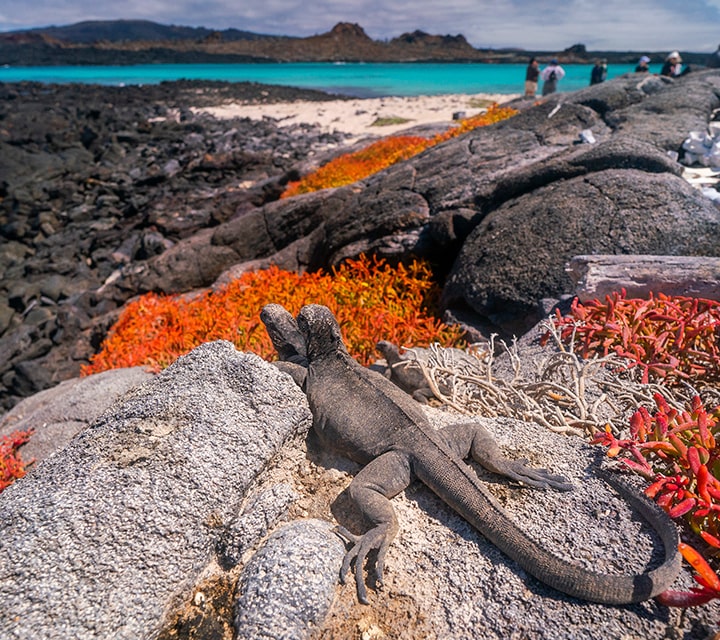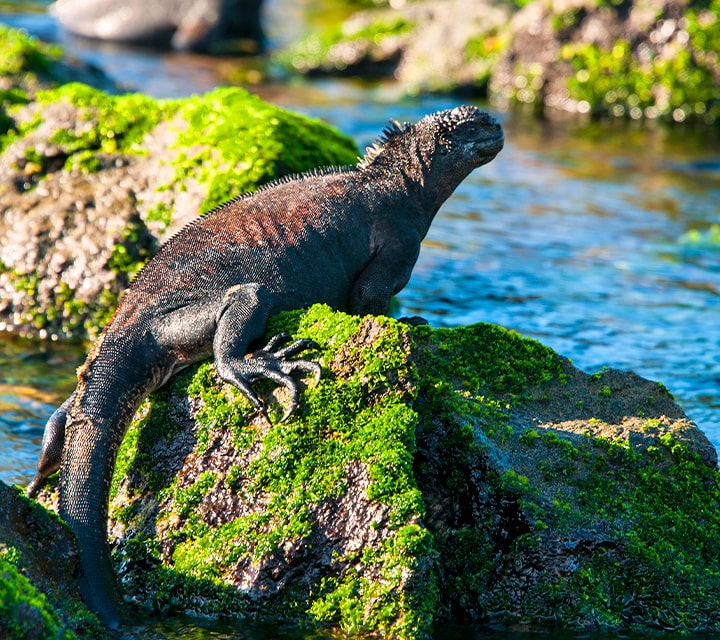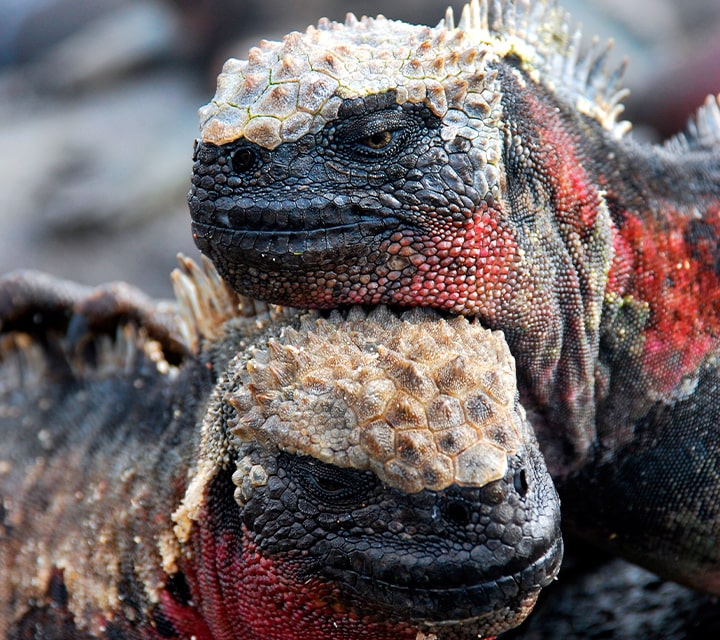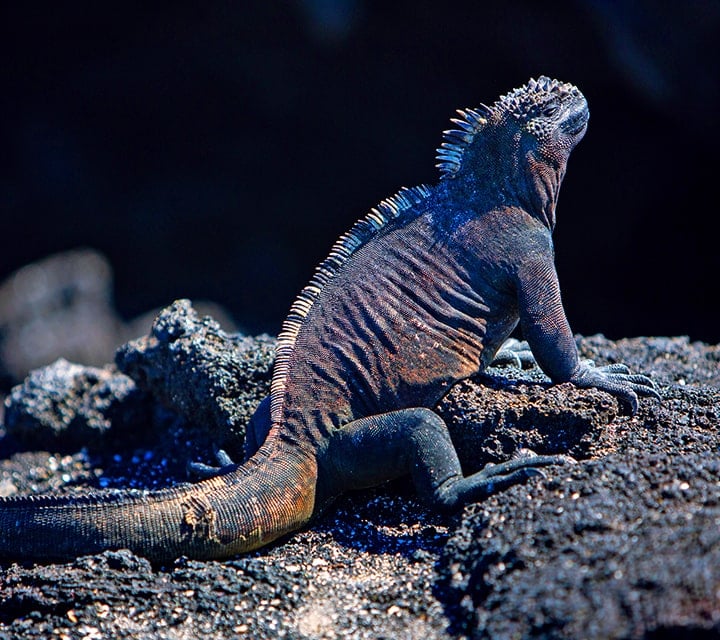
A sighting of the Galapagos marine iguana basking on the shore and slipping into the water to feed is an enduring highlight for any visitor to the remote and mysterious islands. Darwin himself was mightily impressed by their remarkable adaptations even though he was thoroughly put off by the “hideous” appearance of these “disgusting clumsy lizards”.
Although he was much kinder to the finches, Darwin nonetheless noted the unique evolutionary developments that allowed this harmless giant to thrive where its terrestrial cousins on the mainland would surely fail. The physiology that made for their “sluggish” movements on land allowed them to glide effortlessly through the water in search of food, and their “singularly stupid” blunt facial structure was nonetheless profoundly effective for nibbling algae off the slippery rocks on the coast.
For the modern visitor, the beauty of the marine iguana is on full display, and its fascinating variety and exotic lifestyle have made it a celebrated and beloved fixture on the Galapagos Archipelago ever since the Beagle sailed by. These incredible traits make the marine iguana a true evolutionary exemplar and a focal point of any excursion to the Galapagos Islands.
But what made them this way, and why are they so specialized compared to similar reptiles? Together, let’s dive deeper into the chilly waters and trek the rugged coastlines these remarkable creatures inhabit and explore what makes them so unique—and so fascinating.
The Unique Habitat of Galapagos Marine Iguanas
The Galapagos marine iguana — or Amblyrhynchus cristatus to the zoologists out there — can only be found in the aforementioned archipelago. There are eleven similar subspecies found on different islands, and each varies in size and color. For example, those near Española and Floreana are the most vibrant, turning a verdant green and red during the mating season.
Marine iguanas have carved out a niche for themselves amidst the stark and often inhospitable environments of the Galapagos, and they’re a common sight on tours or cruises that feature the islands. But their presence here isn’t just an enigmatic attraction—it’s a live exhibit of evolution in action.
The Galapagos are renowned for their volcanic terrain and broad biodiversity, and they serve as both an ancestral home and competitive hunting grounds for the marine iguanas. Though brisk excursions into the chilly foam may cool them considerably, the archipelago’s rocky shores provide ample basking spots for these cold-blooded creatures to reheat and rejoin the fray.

- Evolutionary Advantages: Marine iguanas diverged as a distinct species some 8-10 million years ago, and they likely arrived in the region by rafting. Today, marine iguanas’ flat tails help with underwater propulsion, while their tough teeth and blunt noses are perfect for consuming algae stuck to rocks. They also boast unique glands that remove the excess salt from their body they accumulate while foraging in the water.
- Diverse Galapagos Diet: The main reason Galapagos marine iguanas swim is to maximize the available feeding grounds the islands provide. While red and green algae make up the majority of their meal plan, marine iguanas have to sample all of the archipelago’s treats; crustaceans, grasshoppers, and even some land-based plants are all on the menu.
- Sunbathing and Salt Sneezing: Remember the salt-removing gland? Well, it works by sneezing. Much like their need to bathe in the sunlight of the shoreline, marine iguanas are compelled to sneeze or spit out their excess salt—so don’t be alarmed if you see it in action!
Marine Iguanas and Their Incredible Adaptations
Because of its one-of-a-kind environment, Galapagos marine iguanas have had to come up with some ingenious evolutionary tricks to make the most of their isolated homeland. Like all successful species, they’ve managed to adapt to almost every challenge the Ecuadorian islands have thrown their way.
Adaptability is a hallmark of this survival-oriented species, and it’s clear that they’ve grown to harness the full bounty of their native isles. They get the best of both worlds: plentiful algae in the cool depths, and brilliant sunlight on the Galapagos’ ray-soaked beaches.
When marine iguanas dive for food, they can reach depths of up to 98 feet, spending 30 minutes or more in the chilly water. As they hunt for food, they may lose up to 10°C from their body temperature, which they recharge back to a cozy 36°C by basking on the shore. Imagine seeing some of these motivated hunters diving into the cool water from your vantage point on a yacht!

But every day isn’t a beach vacation for these rugged reptiles, and some of their adaptations result from existential threats. Marine iguanas have the amazing power to shrink, not just in weight, but also in length. During an El Niño event, which causes warmer waters that significantly affect algae growth, marine iguanas can shrink as much as 20%. This reduction in body size means lower energy requirements, allowing them to survive until conditions improve.
Marine Iguana Behaviors and Physical Traits
Marine iguanas exhibit various intriguing behaviors and physical characteristics honed over millions of years, but their most eye-catching and exciting period is during their mating phase, when the marine iguanas’ reproductive cycles are in full swing.
During the mating season, males exhibit territorial behavior and entire groups embark on what is known as a “lek” mating system. These are aggregations of iguanas that engage in courtship rituals and competition in hopes of impressing a prospective partner. Watching the puffed-up males jockey for hierarchy can be just as captivating for visitors as it is for the females watching on the sidelines.

The mating season is also when the male iguanas shift to more exotic and vibrant colors. This color change is not only a visual spectacle but also a crucial part of their mating strategy, flaunting their wild chromatic flair to attract female partners. While marine iguanas are predominantly black or gray during most of the year, the males can turn various colors: emerald green, crimson, bright yellow, turquoise, and anything in between. However, the exact coloration depends on their subspecies.
Post-mating, females lay their eggs in nests dug into sandy terrain. They spend the next several days guarding their brood before leaving them unattended for the remainder of incubation, which is approximately 3 months.

Experiencing the Galapagos Marine Iguana’s Journey
In this expedition into the incredible lives of marine iguanas, we’ve learned about their unique habitat, incredible adaptations, and captivating behaviors, giving us a glimpse of their continuous saga of evolution and survival. The Galapagos marine iguana is a perfect example of the tenacity, novelty, and diversity of these awe-inspiring islands.
Here's a recap of all the remarkable facts we explored:
- A Semi-Aquatic Maverick: Unlike their terrestrial counterparts, marine iguanas have evolved to forage in the sea for algae, their primary food source, showcasing an unusual affinity for cold water among reptiles.
- Galapagos Natives: Marine iguanas have grown to harness the full bounty of their island home, thriving amidst the volcanic harshness and varied ecosystems. With eleven subspecies dotting each island, they are true Galapagos icons.
- Shrinking and Salt Sneezing: These reptiles adapted to live both in and out of the water, spitting or sneezing to expel extra salt using special glands. They are also known for their ability to shrink when food is low—not just in weight, but in length!
- Colorful Courtship: The rugged reptiles have complex mating habits, which include a dash of color; males shift from their usual black tones to red, yellow, green, and turquoise to attract their mating partners.
- Evolutionary Icon: The journey of marine iguanas, from their divergence as a distinct species to their modern array of practical adaptations, provides a real-life exhibit of evolutionary progress in action.
To learn even more & go into more depth: Galapagos Marine Iguanas
The marine iguana’s unique characteristics, intriguing behavior, and jaw-dropping seasonal color shifts make it a must-see when visiting the Galapagos Islands. If you’re looking for a way to meet these evolutionary marvels in person, now is the perfect time to book a Galapagos luxury cruise with Quasar Expeditions!


